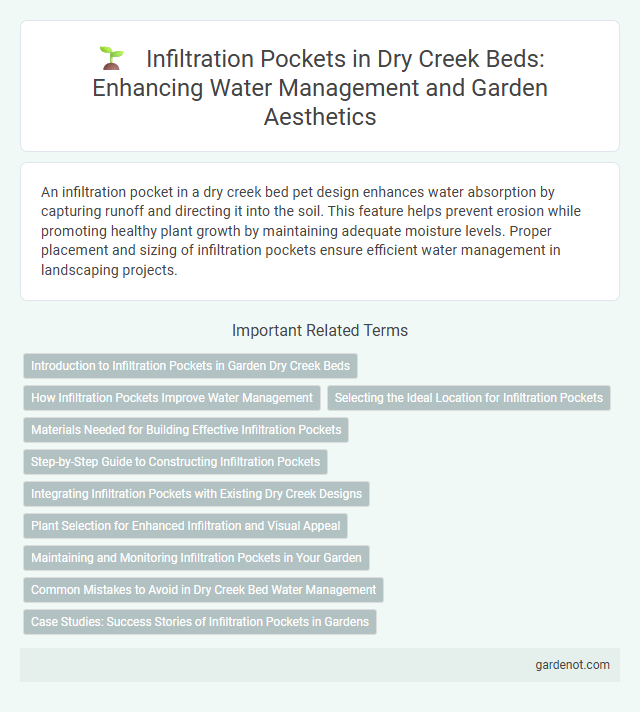An infiltration pocket in a dry creek bed pet design enhances water absorption by capturing runoff and directing it into the soil. This feature helps prevent erosion while promoting healthy plant growth by maintaining adequate moisture levels. Proper placement and sizing of infiltration pockets ensure efficient water management in landscaping projects.
Introduction to Infiltration Pockets in Garden Dry Creek Beds
Infiltration pockets are strategically designed depressions within garden dry creek beds that enhance water absorption and reduce surface runoff by directing stormwater into the soil. These pockets improve groundwater recharge and prevent erosion by capturing rainwater flow, making them an essential component in sustainable landscape design. Incorporating infiltration pockets in dry creek beds supports healthy vegetation growth and promotes efficient water management in residential and urban gardens.
How Infiltration Pockets Improve Water Management
Infiltration pockets enhance water management by capturing stormwater runoff and allowing it to percolate slowly into the ground, reducing surface erosion and improving groundwater recharge. These pockets reduce the strain on drainage systems by temporarily holding water, which helps prevent flooding and manages peak flow during heavy rains. Strategically placed infiltration pockets in dry creek beds promote healthier landscapes by sustaining soil moisture and supporting vegetation growth.
Selecting the Ideal Location for Infiltration Pockets
Selecting the ideal location for infiltration pockets in a dry creek bed involves analyzing soil permeability, slope gradient, and existing vegetation to maximize water absorption and minimize runoff. Sites with sandy or loamy soils and moderate slopes promote effective infiltration, while avoiding areas prone to erosion or compaction maintains structural integrity. Proper placement supports groundwater recharge and reduces flood risks by capturing stormwater efficiently within the creek bed ecosystem.
Materials Needed for Building Effective Infiltration Pockets
Effective infiltration pockets require materials such as porous gravel or crushed stone to promote water absorption and prevent sediment clogging. Incorporating a layer of geotextile fabric helps separate soil from aggregate, maintaining permeability and structural integrity. Organic mulch or compost can be added to enhance soil moisture retention and support vegetation growth around the pocket.
Step-by-Step Guide to Constructing Infiltration Pockets
Constructing infiltration pockets in a dry creek bed involves excavating small depressions along the flow path to capture and slow stormwater runoff, promoting groundwater recharge. Begin by selecting locations with suitable soil permeability, then dig pockets approximately 1 to 2 feet deep and 3 to 4 feet wide, ensuring they are spaced strategically to maximize infiltration. Backfill with a mix of coarse sand, gravel, and native soil to enhance water percolation while preventing erosion and sediment buildup.
Integrating Infiltration Pockets with Existing Dry Creek Designs
Integrating infiltration pockets within existing dry creek bed designs enhances stormwater management by promoting localized water absorption and reducing runoff volume. These strategically placed pockets improve groundwater recharge and mitigate erosion by slowing water flow in critical areas. Utilizing permeable materials within infiltration pockets further optimizes filtration and supports sustainable landscape practices.
Plant Selection for Enhanced Infiltration and Visual Appeal
Selecting deep-rooted native grasses and drought-tolerant perennials for infiltration pockets in a dry creek bed enhances soil permeability and water absorption. Species like blue grama, black-eyed Susan, and prairie dropseed create a robust root system that stabilizes soil while adding vibrant textures and colors. Incorporating diverse plants ensures functional infiltration benefits and complements the natural aesthetics of the creek environment.
Maintaining and Monitoring Infiltration Pockets in Your Garden
Regular maintenance of infiltration pockets in your garden prevents clogging by sediment and organic debris, ensuring optimal water absorption. Monitoring soil moisture levels around the pocket helps identify areas where infiltration efficiency may be declining. Incorporating periodic inspections and cleaning extends the lifespan of infiltration pockets and supports sustainable stormwater management.
Common Mistakes to Avoid in Dry Creek Bed Water Management
Infiltration pockets in dry creek beds often suffer from improper sizing and placement, leading to inadequate water absorption and increased erosion risk. Failing to use appropriate soil amendments can reduce permeability, causing water to pool rather than infiltrate efficiently. Ignoring maintenance needs like sediment removal clogs infiltration zones and disrupts the intended hydrological function.
Case Studies: Success Stories of Infiltration Pockets in Gardens
Infiltration pockets have demonstrated significant success in garden water management by effectively capturing stormwater and enhancing soil moisture retention, as evidenced by case studies from urban landscaping projects in California and Australia. These installations have led to a measurable increase in groundwater recharge rates, reducing surface runoff and supporting drought-resistant plant growth. Data from the University of California extension highlights a 40% improvement in soil infiltration capacity within six months after implementing infiltration pockets in community gardens.
Infiltration pocket Infographic

 gardenot.com
gardenot.com